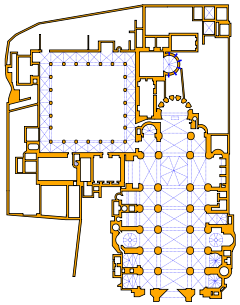


Cathedral of Tarragona is a Roman Catholic Church dedicated to Santa Maria de Tarragona. Like many Christian European churches, Tarragona Cathedral was built on site of much older pagan temple of god Jupiter that was constructed in the 1st century AD during rule of Emperor Tiberius. Later Visigoths built their own Christian church that later was transformed into a Muslim Mosque after it was captured during Arab invasion. Current Tarragona Cathedral was constructed in 1171 AD and finally consecrated in 1331 AD. it was finally completed in 1350.
Magnificent staircase leads to the Tarragona Cathedral from the central facade and the main portal is decorated with magnificent carved base- relief depicting scenes of the Last Judgment, the statue of the Virgin Mary and statues of prophets, saints and apostles. Color stained window of the the main entrance is made in the shape of a rose. Tarragona Cathedral Bell tower contains fifteen bells. The oldest bell dates back to the 14th century. Museum of the Diocese is situated in the eastern part of the cathedral. It holds an extensive collection of artifacts dedicated to the history of Tarragona Cathedral.
Beginnings of construction
It seems also that the initial construction was planned as a single
nave , with a large apse , robust walls and basically corresponding
to a style corresponding to the existing in their environment at
that time, that is, it would be a Romanesque cathedral , also
thought as an element defensive and, therefore, provided with
machicolations , battlements and walkway, as well as elevated
windows, out of reach of the enemy (years later, with the security
already guaranteed, would open under the previous three new windows
in the apse, of larger and located closer to the ground).
In spite of this, it is not necessary to suppose that it was an
austere construction, since it collected a good number of decorative
elements typical of Romanesque, which gave the apse of the cathedral
the due prestige.
Contemporaries of the apse are the sacristy and the refectory . The
sacristy, located next to the main apse, is rectangular in plan, and
has a pointed barrel vault . The sacristy has suffered over the
years several interventions that have substantially modified its
appearance.
The size of the refectory (or dining room) indicates that the number
of canons and other employees of the cathedral had increased
substantially. From the sixteenth century , when the canons began to
stop living together, the refectory ended up transformed into a
chapel over the cathedral. The construction of a belfry , which was
planned to be built next to the sacristy, was also planned; bell
tower that also had defensive character.
Modification of the plans at the end of the 12th century
Towards year 1195 a substantial change in the approach of the works
took place, magnifying them, which produced strong problems of
social type in the city, when complaining the citizens of Tarragona
of the high expenses that the works entailed, expenses that had to
be borne with the corresponding taxes , which caused that in 1214
the archbishop of Tarragona decreed the voluntariness of the
contributions to the works.
Basically, the new project aimed to enlarge the cathedral, to turn
it into a building formed by three naves in a basilical plan , with
a transept and four new secondary apses , covered with ribbed vault
of Gothic style . By the previous spatial arrangement, the only
place in which it was possible to carry out the enlargement was the
point where the courtyard had been left for the future cloister ,
which made the usual alignment of the transept and the five apses
impossible. Therefore, the four smaller apses were staggered (as it
is perfectly perishable in the plane that is on the right), so the
absidiola The north is smaller than the southern one.